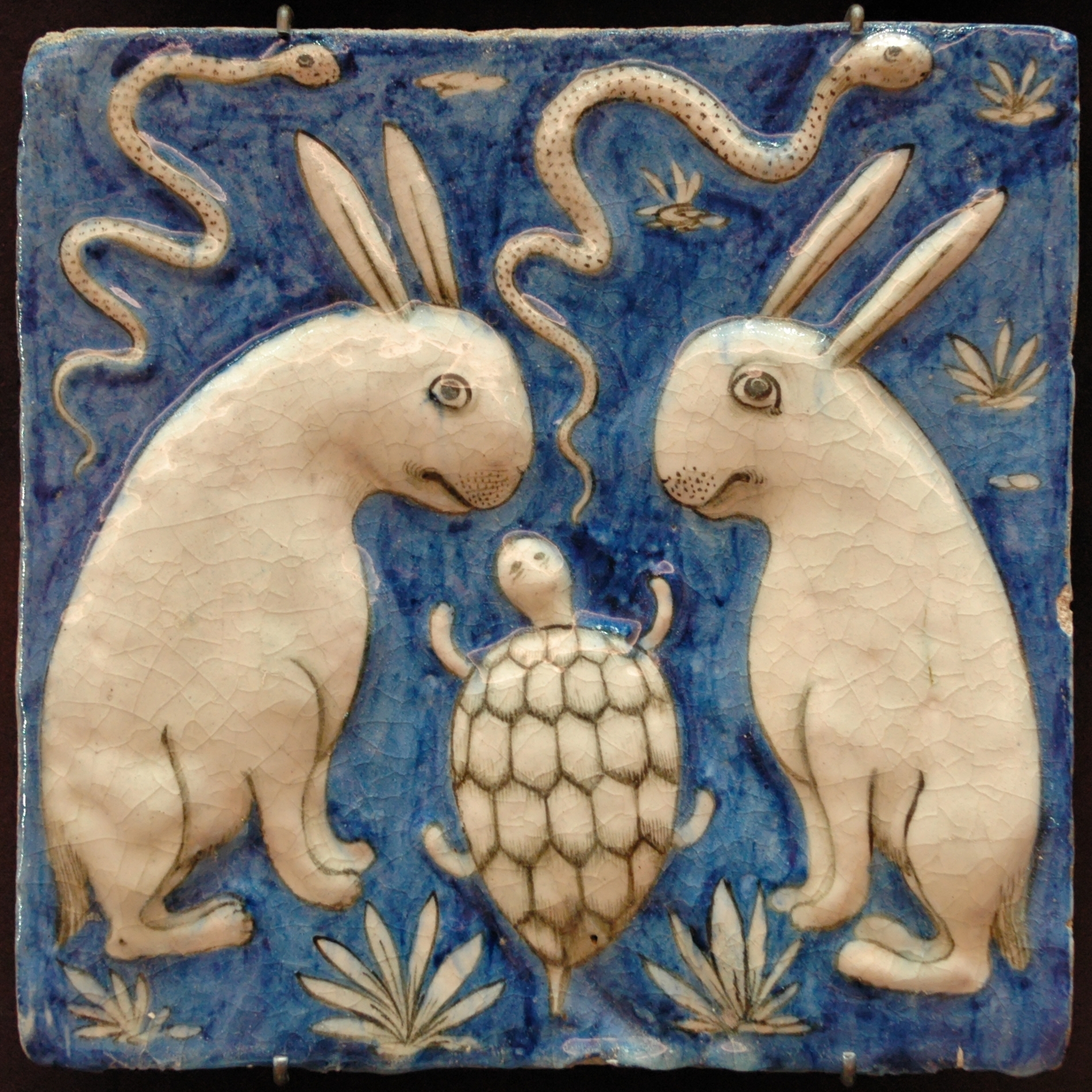|
Saj'
Saj' () is a form of rhymed prose defined by its relationship to and use of end-rhyme, meter, and parallelism. There are two types of parallelism in saj': ''iʿtidāl'' (rhythmical parallelism, meaning "balance") and ''muwāzana'' (qualitative metrical parallelism). Saj' was the earliest artistic speech in Arabic. It could be found in pre-Islamic Arabia among the ''kuhhān'' (the pre-Islamic soothsayers) and in Abyssinia for ecclesiastical poetry and folk songs. One famous composer of saj' was said to have been the bishop of Najran, Quss Ibn Sa'ida al-Iyadi. Saj' continued in Islamic-era Arabic literature and speech. The stylistic similarities between saj' and the Quran have long been a matter of discussion especially between saj' and the style of the earliest surahs. In Umayyad times, saj' was discredited as an artistic style for resembling the speech of soothsayers. This, however, did not stop people from composing saj'. Saj' in the style of pre-Islamic Arabia was still ... [...More Info...] [...Related Items...] OR: [Wikipedia] [Google] [Baidu] |
Rhymed Prose
Rhymed prose is a literary form and literary genre, written in Meter (poetry), unmetrical rhymes. This form has been known in many different cultures. In some cases the rhymed prose is a distinctive, well-defined style of writing. In modern literary traditions the boundaries of poetry are very broad (free verse, prose poetry, etc.), and some works may be described both as prose and poetry. Arabic culture and influences In classic Arabic literature, a famous form of rhymed prose is known as ''saj'''. Saj' is considered by many to be the earliest form of artistic speech in Arabic dating to Pre-Islamic Arabia, pre-Islamic times, and some reconstructions make it out to be a predecessor of metered poetic verse in Arabic. Rajaz may have been an intermediary for this process. An elaborate Arabic kind of rhymed prose is ''maqama''. It influenced other cultures of the Muslim world, such as Persian literature, Persian (as exemplified by Saadi (poet), Saadi's ''Gulistan of Sa'di, Gulestan'') ... [...More Info...] [...Related Items...] OR: [Wikipedia] [Google] [Baidu] |
Maqama
The ''maqāma'' (Arabic: مقامة aˈqaːma literally "assembly"; plural ''maqāmāt'', مقامات aqaːˈmaːt is an (originally) Arabic prosimetric literary genre of picaresque short stories originating in the tenth century C.E.Qian, A. (2012)The Maqāmah as Prosimetrum: A Comparative Investigation of its Origin, Form and Function npublished doctoral dissertation University of Pennsylvania. The ''maqāmāt'' are anecdotes told by a fictitious narrator which typically follow the escapades of a roguish protagonist as the two repeatedly encounter each other in their travels. The genre is known for its literary and rhetorical complexity, as well as its alternating use of rhymed verse with a form of Arabic rhymed prose known as ''saj'''. The two most well-known authors within the genre are Badī' al-Zaman al-Hamadhāni, one of its earliest exponents, and al-Harīrī of Basra, whose ''maqāmāt'' are commonly held responsible for the genre's rise in popularity from the elev ... [...More Info...] [...Related Items...] OR: [Wikipedia] [Google] [Baidu] |
Quranic Exegesis
Tafsir ( ; ) refers to an exegesis, or commentary, of the Quran. An author of a ''tafsir'' is a ' (; plural: ). A Quranic ''tafsir'' attempts to provide elucidation, explanation, interpretation, context or commentary for clear understanding and conviction of God's will in Islam. Principally, a ''tafsir'' deals with the issues of linguistics, jurisprudence, and theology. In terms of perspective and approach, ''tafsir'' can be broadly divided into two main categories, namely ''tafsir bi-al-ma'thur'' (lit. received tafsir), which is transmitted from the early days of Islam through the Islamic prophet Muhammad and his companions, and ''tafsir bi-al-ra'y'' (lit. ''tafsir'' by opinion), which is arrived through personal reflection or independent rational thinking. There are different characteristics and traditions for each of the ''tafsirs'' representing respective schools and doctrines, such as Sunni Islam, Shia Islam, and Sufism. There are also general distinctions between cl ... [...More Info...] [...Related Items...] OR: [Wikipedia] [Google] [Baidu] |
Surah 53
An-Najm (, ; The Star) is the 53rd chapter (surah) of the Quran, with 62 verses ( āyāt). The surah opens with the oath of the Divine One swearing by every one of the stars, as they descend and disappear beneath the horizon, that Muhammad is indeed God's awaited Messenger. It takes its name from Ayat #1, which mentions "the stars" (''najm''). The surah confirms the divine source of the Prophet's message and refers to his ascension to heaven during the Night Journey (Ayah#1 ff.). The surah refutes the claims of the disbelievers about the goddesses and the angels (ayah#19 ff.), and lists several truths about God's power. It closes with a warning of the imminent Day of Judgement. Regarding the timing and contextual background of the believed revelation (''asbāb al-nuzūl''), it is an earlier "Meccan surah", which means it is believed to have been revealed in Mecca, rather than later in Medina. The surah is distinguished as being the first that required Muslims to prostrat ... [...More Info...] [...Related Items...] OR: [Wikipedia] [Google] [Baidu] |
Musaylima
Musaylima (), d.632, was a claimant of prophethood from the Banu Hanifa tribe. Based from Diriyah in present day Riyadh, Saudi Arabia, he claimed to be a prophet and was an enemy of Islam in 7th-century Arabia. He was a leader of the enemies of Islam during the Ridda wars. He is considered by Muslims to be a false prophet (). He is commonly called Musaylima al-Kadhāb () by Muslims. Musaylima was said to have composed in saj', a type of rhymed prose that was common in pre-Islamic artistic speech. Etymology Musaylima's actual name was '' Maslama'', but Muslims altered his name to Musaylima, which is the diminutive of Maslama (i.e., 'Little Maslama'). The name ''maslama'' contains an Arabic or Syriac participal-nominal substratum like ''muslim'' (submitter). Maslama may be a title derived from ''aslam'' which is a verb associated with prophethood. Early life Musaylima was the son of Habib, of the tribe Banu Hanifa, one of the largest tribes of Arabia that inhabited the region of Na ... [...More Info...] [...Related Items...] OR: [Wikipedia] [Google] [Baidu] |
Ta'abbata Sharran
Thabit ibn Jabr, better known by his epithet Ta'abbata Sharran (; lived late 6th century or early 7th century CE) was a Pre-Islamic Arabic poetry, pre-Islamic Arabic poet of the ''su'luk'' (vagabond) school. He lived in the Arabian Peninsula near the city of Ta'if, and was a member of the tribe. He was known for engaging in tribal conflict with the Banu Hudhayl and Bajila tribes. He wrote poems about tribal warfare, the hardships of desert life, and ghouls. His work was prominent in the early poetic anthologies, being preserved in both the ''Mufaddaliyat'' (8th century) and the ''Kitab al-Hamasah, Hamasah'' (9th century). Details of his life are known only from pseudo-historical accounts in the poetic anthologies and the ''Kitab al-Aghani''. Name His proper name was Thabit ibn Jabr al-Fahmi. Al-Fahmi is a ''Nisba (onomastics), nisba'' indicating his membership in the Fahm tribe. Ta'abatta Sharran is a ''Arabic name#Laqab, laqab,'' or nickname, which means "he who had evil unde ... [...More Info...] [...Related Items...] OR: [Wikipedia] [Google] [Baidu] |
Al-Qalqashandi
Shihāb al-Dīn Abū 'l-Abbās Aḥmad ibn ‘Alī ibn Aḥmad ‘Abd Allāh al-Fazārī al-Shāfiʿī better known by the epithet al-Qalqashandī (; 1355 or 1356 – 1418), was a medieval Arab Egyptian encyclopedist, polymath and mathematician. A native of the Nile Delta, he became a Scribe of the Scroll (''Katib al-Darj''), or clerk of the Mamluk chancery in Cairo, Egypt. His magnum opus is the voluminous administrative encyclopedia ''Ṣubḥ al-Aʿshá''. ''Ṣubḥ al-aʿshā'' ''Ṣubḥ al-Aʿshá fī Ṣināʿat al-Inshāʾ'' ('The Dawn of the Blind' or 'Daybreak for the Night-Blind regarding the Composition of Chancery Documents'); a fourteen-volume encyclopedia completed in 1412, is an administrative manual on geography, political history, natural history, zoology, mineralogy, cosmography, and time measurement. Based on the ''Masālik al-abṣār fī mamālik al-amṣar'' of Shihab al-Umari Shihab al-Din Abu al-Abbas Ahmad Ibn Fadlallah al-Umari (), commonly k ... [...More Info...] [...Related Items...] OR: [Wikipedia] [Google] [Baidu] |
Zakariya Al-Qazwini
Zakariyya' al-Qazwini ( , ), also known as Qazvini (), (born in Qazvin, Iran, and died 1283), was a Cosmography, cosmographer and Geography in medieval Islam, geographer. He belonged to a family of jurists originally descended from Anas bin Malik (a companion of the Islamic prophet Muhammad) which had been well established in Qazvin long before al-Qazwini was born. His most famous work is the Aja'ib al-Makhluqat, (), a seminal work in cosmography. He is also the author of the geographical dictionary (). Career Born in Qazvin to a Persianized family of Arab ancestry, al-Qazwini served as a legal expert and judge in several localities in Iran. He traveled around in Mesopotamia and the Levant, and finally entered the circle patronized by the Ilkhanid governor of Baghdad, Ata-Malik Juvayni (d. 1283 CE). It was to the latter that al-Qazwini dedicated his famous cosmography titled Aja'ib al-Makhluqat, (). This treatise, frequently illustrated, was immensely popular and is preser ... [...More Info...] [...Related Items...] OR: [Wikipedia] [Google] [Baidu] |
Metre (poetry)
In poetry, metre ( Commonwealth spelling) or meter ( American spelling; see spelling differences) is the basic rhythmic structure of a verse or lines in verse. Many traditional verse forms prescribe a specific verse metre, or a certain set of metres alternating in a particular order. The study and the actual use of metres and forms of versification are both known as prosody. (Within linguistics, " prosody" is used in a more general sense that includes not only poetic metre but also the rhythmic aspects of prose, whether formal or informal, that vary from language to language, and sometimes between poetic traditions.) Characteristics An assortment of features can be identified when classifying poetry and its metre. Qualitative versus quantitative metre The metre of most poetry of the Western world and elsewhere is based on patterns of syllables of particular types. The familiar type of metre in English-language poetry is called qualitative metre, with stressed syllables comin ... [...More Info...] [...Related Items...] OR: [Wikipedia] [Google] [Baidu] |
Accentual Verse
Accentual verse has a fixed number of stresses per line regardless of the number of syllables that are present. It is common in languages that are stress-timed, such as English, as opposed to syllabic verse which is common in syllable-timed languages, such as French. Children's poetry Accentual verse is particularly common in children's poetry; nursery rhymes and the less well-known skipping-rope rhymes are the most common form of accentual verse in the English Language. The following poem, "Baa Baa Black Sheep," has two stresses in each line but a varying number of syllables. Bold represents stressed syllables, and the number of syllables in each line is noted. Baa, baa, black sheep, (4) Have you any wool? (5) Yes sir, yes sir, (4) Three bags full; (3) One for the mas-ter, (5) And one for the dame, (5) And one for the lit-tle boy (7) Who lives down the lane. (5) Accentual verse derives its musical qualities from its flexibility with unstressed syllables and tends to fol ... [...More Info...] [...Related Items...] OR: [Wikipedia] [Google] [Baidu] |
Prosody (linguistics)
In linguistics, prosody () is the study of elements of speech, including intonation, stress, rhythm and loudness, that occur simultaneously with individual phonetic segments: vowels and consonants. Often, prosody specifically refers to such elements, known as ''suprasegmentals'', when they extend across more than one phonetic segment. Prosody reflects the nuanced emotional features of the speaker or of their utterances: their obvious or underlying emotional state, the form of utterance (statement, question, or command), the presence of irony or sarcasm, certain emphasis on words or morphemes, contrast, focus, and so on. Prosody displays elements of language that are not encoded by grammar, punctuation or choice of vocabulary. Attributes of prosody In the study of prosodic aspects of speech, it is usual to distinguish between auditory measures ( subjective impressions produced in the mind of the listener) and objective measures (physical properties of the sound wave and ... [...More Info...] [...Related Items...] OR: [Wikipedia] [Google] [Baidu] |





